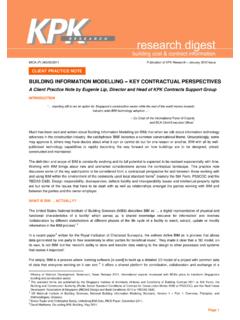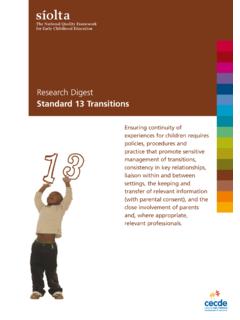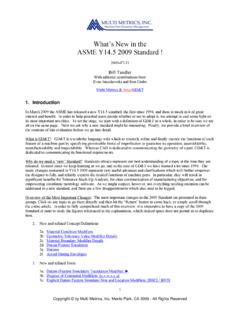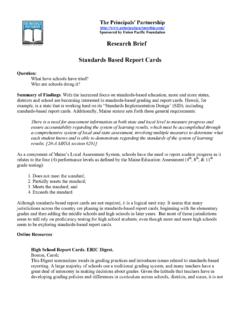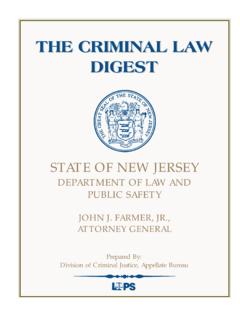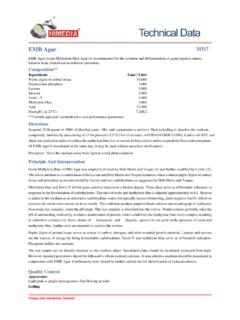Transcription of VALUE ENGINEERING AND VALUE MANAGEMENT IS THERE …
1 Page 1 A Client Practice Note by Dr Roy Barton, Australian Centre for VALUE MANAGEMENT (ACVM) VALUE ENGINEERING AND VALUE MANAGEMENT IS THERE ANY DIFFERENCE? Many a time, one is often asked What is the difference between VALUE MANAGEMENT and VALUE ENGINEERING ? This practice note shall deal with this question in the context of the Singapore construction sector. In Singapore, as in other parts of the world, the terms VALUE ENGINEERING and VALUE MANAGEMENT are sometimes used synonymously and sometimes as though they are different processes. What actually makes them different, however, is usually not defined. Where THERE is a distinction in use, VALUE ENGINEERING seems always to be associated with the pursuit of cost reduction (the classic VALUE ENGINEERING definition is finding the lowest cost to perform required functions) whereas VALUE MANAGEMENT may not necessarily be focused on cost reduction at all, but on much broader project-considerations of VALUE .
2 Sadly, THERE seems to be a widespread view throughout the Singapore construction sector that VALUE ENGINEERING is just another name for cost cutting . Why sadly ? This is because THERE is a complete misconception of what VALUE ENGINEERING is and does. When we are thinking about VALUE ENGINEERING , it is important to recognise that VALUE or VALUE for money must be part of the consideration. THERE is no exception to this. The world is peppered with projects where costs have been cut without considering VALUE and VALUE for money. Unwanted compromise is the result, often leading to even higher costs and poor performance. This widespread misunderstanding of the term VALUE ENGINEERING as a cost cutting process, might also apply to the term VALUE MANAGEMENT , but perhaps less so. THERE is, however, at least some cynicism suggesting that recent government initiatives relating to VALUE MANAGEMENT are simply government cost-cutting measures by another name.
3 The points made above about VALUE and VALUE for money apply here, too. In any VALUE MANAGEMENT study, THERE must be consideration of VALUE or VALUE for money. Regarding differences between VALUE ENGINEERING and VALUE MANAGEMENT , the truth of the matter is that THERE is no universally agreed distinction between the terms VALUE ENGINEERING and VALUE MANAGEMENT . Both terms are in current use, sometimes being used in different ways, with different applications. Many people and organisations use the terms quite synonymously. Even a cursory review of the international literature will verify this. The most recent (2011) publication from the United States Defence Department, for example, quite explicitly states that VALUE ENGINEERING and VALUE MANAGEMENT are to be considered synonymously. In writing the first edition (1994) and the current second edition (2007) of the Australian Standard on VALUE MANAGEMENT , we wrestled at length with this question of distinguishing VALUE ENGINEERING from VALUE MANAGEMENT , and, on both occasions came to the same decision.
4 We chose to use the single term VALUE MANAGEMENT as an inclusive phrase that also embraced the terms VALUE Analysis and VALUE ENGINEERING in exactly the same way that the United States Defence Department has now also done. This was not an easy decision, yet with the passage of time, it is believed to have been the most appropriate one. In arriving at this decision, we (the members of the Australian Standards committee) noted that regardless of which term ( VALUE ENGINEERING or VALUE MANAGEMENT ) was used, the core process (for each) centres around a multi-disciplinary workshop in which a series of prescribed steps are followed where VALUE , or VALUE for money is a primary consideration (these steps are referred to in the United States of America as a job plan , and in the Australian Standard as a work plan ). This was a major factor in Publication of KPK Research July 2012 Issue MICA (P) 166/03/2013 VALUE ENGINEERING AND VALUE MANAGEMENT IS THERE ANY DIFFERENCE?
5 This Client Practice Note is an inaugural issue of a series of featured articles from our invited specialist expert contributors. In this first article, Dr Roy Barton of the Australian Centre for VALUE MANAGEMENT (ACVM) examines the distinguishing differences between VALUE ENGINEERING and VALUE MANAGEMENT CLIENT PRACTICE NOTE Page 2 A Client Practice Note by Dr Roy Barton, Australian Centre for VALUE MANAGEMENT (ACVM) VALUE ENGINEERING AND VALUE MANAGEMENT IS THERE ANY DIFFERENCE? guiding our decision not to distinguish between the terms. Clearly, any difference was to do with application, not core method. The prescribed steps (as listed in the Australian Standard) are: Build shared knowledge and understanding of the context, VALUE factors, and project details. Generate ideas to enhance VALUE and VALUE for money. Evaluate the ideas. Develop proposals.
6 Make recommendations. Produce an action plan. We must understand, therefore, that any distinction that we make between VALUE ENGINEERING and VALUE MANAGEMENT is completely a matter of choice. Any organisation is free to distinguish between the terms however it wishes. The terms VALUE ENGINEERING and VALUE MANAGEMENT have no legal protection and no universally agreed distinction between them. In this paper, if we are to make a distinction between VALUE ENGINEERING and VALUE MANAGEMENT (recognising that many people and organisations make no distinction at all) then that distinction will be to do with the application of a common, core process. The core elements of the process of VALUE ENGINEERING and VALUE MANAGEMENT are, for all intents and purposes, identical; but the way in which the core process is applied may be very different from circumstance to circumstance.
7 This is particularly so regarding approaches taken to group-facilitation. Conventional VALUE ENGINEERING literature makes no reference (or minimal reference at best) to group facilitation, but in most of the VALUE MANAGEMENT literature, group facilitation is considered to be a major part of the exercise. One way of making a distinction in the application of VALUE ENGINEERING and VALUE MANAGEMENT is to consider the nature of the problem being dealt with. Through the last decade or so, such distinction has often been based on the perceived hardness or softness of the problem. An example of a hard problem situation is a choice between reinforced concrete and structural steel for the frame of a high rise building. Such a case is ideally suited to a hard /quantitative methodological analysis and lends itself to conventional VALUE ENGINEERING .
8 A group of technical experts (as typified by conventional VALUE ENGINEERING ) would be able to work through each phase of the VALUE ENGINEERING work plan and, based upon function analysis and life cycle costing, arrive at a decision which delivers the required functions for the lowest cost. This is classic VALUE ENGINEERING . An example of a soft situation is the question of what to do about traffic congestion at a suburban main road intersection. This problem situation is highly complex, as THERE are many potential solutions to this situation. These include implementing non-build solutions such as a demand- MANAGEMENT strategy to reduce the number of vehicles; providing more public transport; changing travel habits of road users; or demolishing the buildings and constructing a flyover. THERE may also be combinations of these options.
9 THERE is no algorithm to solve this. The measurements used are likely to be soft /qualitative (greater than/less than; better than/worse than and the like). THERE are many people potentially affected by the decision. THERE is no single customer. THERE are many interest groups. THERE is no simple cause/effect relationship. A group-process is needed that brings together the key stakeholders hence the emphasis on group facilitation. The VALUE MANAGEMENT work plan provides an ideal structure for the group-process. In cases like this, although we are still using the VALUE ENGINEERING or VALUE MANAGEMENT work plan, it should be clear that the exercise is not about identifying the functions of component parts (concrete, steel, and so on as in the first example of the framed structure) and then selecting the lowest cost alternatives. We could do this once a decision had been taken about inclusion or exclusion of component parts.
10 But in arriving at that decision, we need a much softer approach, dealing with many qualitative parameters and many stakeholders. In both of the examples cited, the prescribed work plan will be followed, but the workshops themselves will look and feel very different. In the one dealing with choices between structural steel and reinforced concrete, the outcomes should be a technical recommendation that shows the lowest life cycle costs have been achieved through the use of structural steel and/or reinforced concrete. In the second case (what to do about the traffic problem at the major intersection), the likely outcome could be a set of principles on which planning and design should proceed or, depending upon how far the initial work has progressed, to identify a number of concept options to go forward for detailed evaluation. VALUE for money will be factored into all of this.

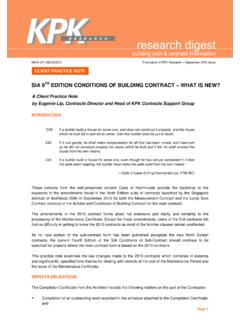
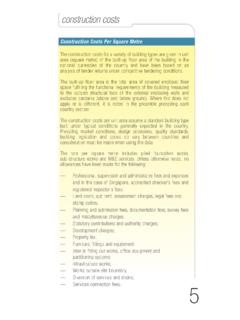
![CLAIMS THE KEY ESSENTIALS [ PART 1 ] - kpkqs.com](/cache/preview/5/b/7/9/c/5/e/1/thumb-5b79c5e12cfb7d73ac152a7099f25fbc.jpg)
